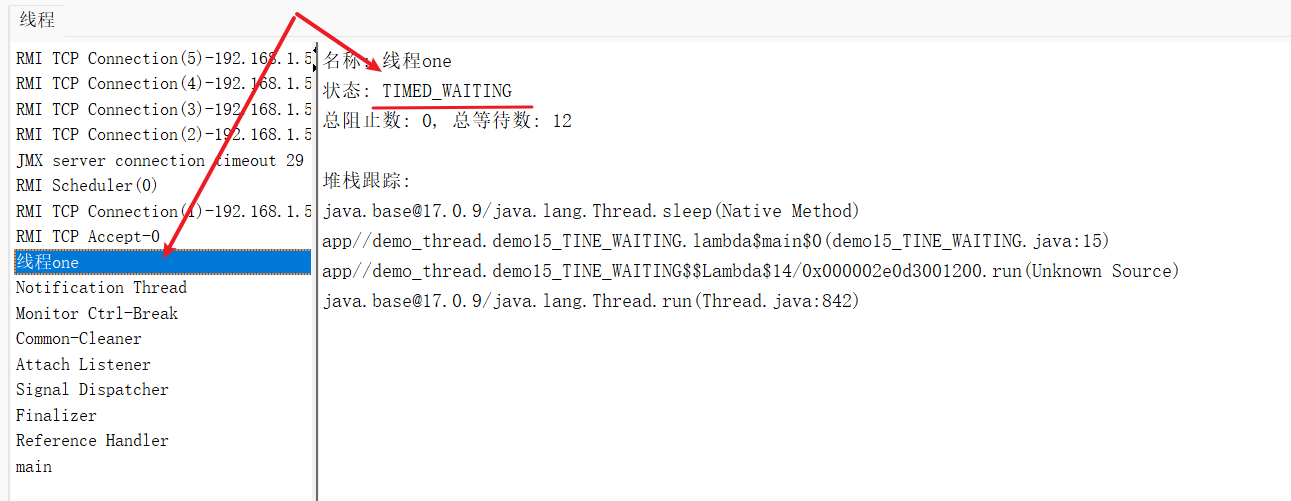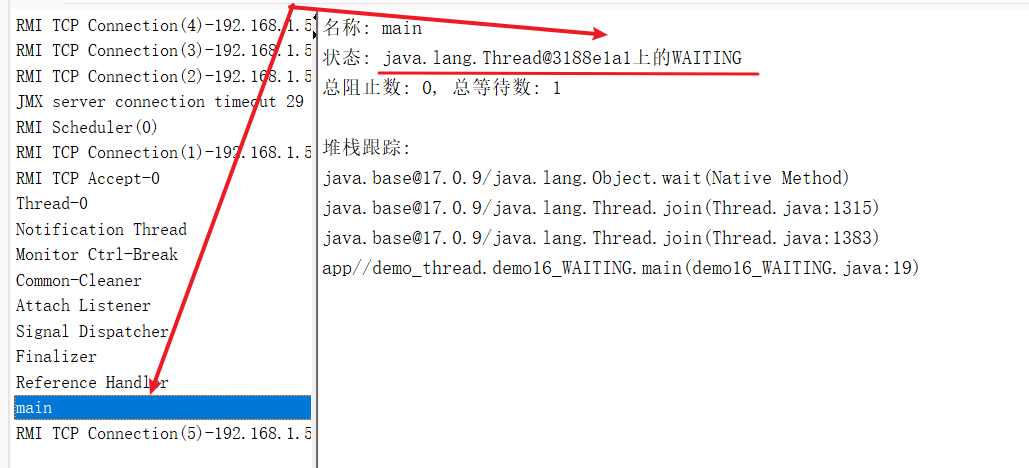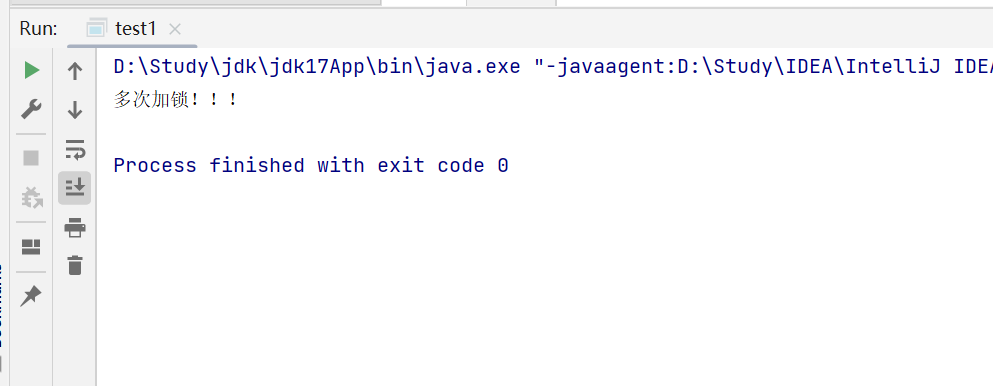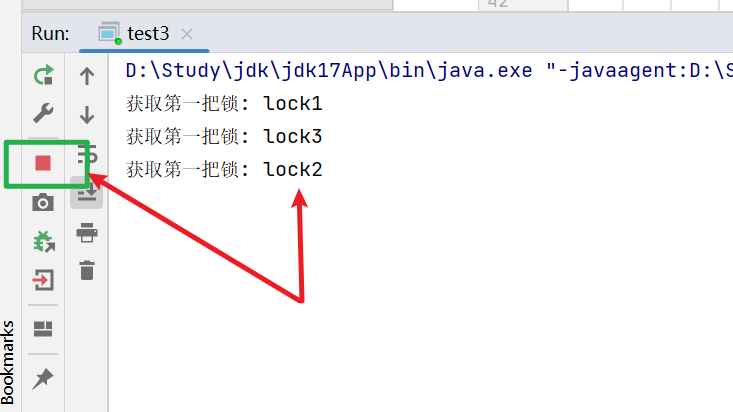文章目录
- [一. 线程创建(start)](#一. 线程创建(start))
- [二. 线程的关键属性](#二. 线程的关键属性)
-
- (一)线程名称
- (二)线程是否为后台线程
-
- [1. 前台线程](#1. 前台线程)
- [2. 后台线程](#2. 后台线程)
- [3. 查看是否是后台线程(isDaemon)](#3. 查看是否是后台线程(isDaemon))
- [4. 设置后台线程(setDaemon)代码及效果图](#4. 设置后台线程(setDaemon)代码及效果图)
- (三)线程是否存活
-
- [1. 是否存活isAlive](#1. 是否存活isAlive)
- [2. 代码及效果图](#2. 代码及效果图)
- [三. 线程终止(interrupt)](#三. 线程终止(interrupt))
-
- (一)Java提供的API
-
- [1. 用法](#1. 用法)
- [2. 代码及效果图](#2. 代码及效果图)
- (二)手动设置条件
-
- [1. 用法](#1. 用法)
- [2. 代码及其效果图](#2. 代码及其效果图)
- [四. 线程等待(join)](#四. 线程等待(join))
- [五. 获取线程引用(currentThread)](#五. 获取线程引用(currentThread))
- [六. 线程休眠(sleep)](#六. 线程休眠(sleep))
- [七. 线程状态](#七. 线程状态)
-
- (一)NEW
-
- [1. 定义](#1. 定义)
- [2. 代码及其效果图](#2. 代码及其效果图)
- (二)TERMINATED
-
- [1. 定义](#1. 定义)
- [2. 代码及其效果图](#2. 代码及其效果图)
- (三)RUNNABLE
-
- [1. 定义](#1. 定义)
- [2. 代码及其效果图](#2. 代码及其效果图)
- (四)TIMED_WAITING
-
- [1. 定义](#1. 定义)
- [2. 代码及其效果图](#2. 代码及其效果图)
- (五)WAITING
-
- [1. 定义](#1. 定义)
- [2. 代码及其效果图](#2. 代码及其效果图)
- (六)BLOCKED&LOCK
一. 线程创建(start)
(一)继承Thread类,重写run
java
class MyThread extends Thread {
@Override
public void run() {
while (true) {
System.out.println("Thread!!!");
try {
Thread.sleep(100);
} catch (InterruptedException e) {
throw new RuntimeException(e);
}
}
}
}
public class demo1 {
public static void main(String[] args) throws InterruptedException {
Thread thread = new MyThread();
thread.start();
while (true) {
System.out.println("main!!!");
Thread.sleep(100);
}
}
}(二)继承Runnable类,重写run
java
class MyRunnable implements Runnable {
@Override
public void run() {
while (true) {
System.out.println("Thread!");
}
}
}
public class demo2 {
public static void main(String[] args) {
MyRunnable runnable = new MyRunnable();
Thread thread = new Thread(runnable);
thread.start();
while (true) {
System.out.println("main!");
}
}
}(三)Thread匿名内部类重写
java
package demo_thread;
/**
* Created with IntelliJ IDEA.
* Description:
* User: 32309
* Date: 2025-07-11
* Time: 20:06
*/
public class demo3 {
public static void main(String[] args) throws InterruptedException {
Thread thread = new Thread() {
@Override
public void run() {
while (true) {
System.out.println("Thread~~");
try {
Thread.sleep(0);
} catch (InterruptedException e) {
throw new RuntimeException(e);
}
}
}
};
thread.start();
while (true) {
System.out.println("main~~");
Thread.sleep(0);
}
}
}(四)Runnable匿名内部类重写
java
package demo_thread;
/**
* Created with IntelliJ IDEA.
* Description:
* User: 32309
* Date: 2025-07-11
* Time: 20:14
*/
public class demo4 {
public static void main(String[] args) throws InterruptedException {
Runnable runnable = new Runnable() {
@Override
public void run() {
while (true) {
System.out.println("thread~");
try {
Thread.sleep(100);
} catch (InterruptedException e) {
throw new RuntimeException(e);
}
}
}
};
Thread thread = new Thread(runnable);
thread.start();
while (true) {
System.out.println("main~");
Thread.sleep(100);
}
}
}(五)lambda表达式
java
public class demo5 {
public static void main(String[] args) throws InterruptedException {
Thread thread = new Thread(() -> {
while (true) {
System.out.println("thread!");
try {
Thread.sleep(10);
} catch (InterruptedException e) {
throw new RuntimeException(e);
}
}
},"阿然");
thread.start();
while (true) {
System.out.println("main!");
Thread.sleep(10);
}
}
}二. 线程的关键属性
(一)线程名称
线程名字,我们可以通过setName方法来设置线程的名字,方便后期调试
通过getName方法可以获取线程名称
(二)线程是否为后台线程
1. 前台线程
当前台线程还在运行时,即使其他所有线程都运行完,进程也不停止,要等待前台线程结束,进程才结束
2. 后台线程
当所有前台线程运行完毕时,即使后台线程还有任务没有完成,也会终止进程
3. 查看是否是后台线程(isDaemon)
是否是后台线程通过isDeamon 方法来查看
Java中线程创建时默认是前台线程
4. 设置后台线程(setDaemon)代码及效果图
java
public class demo7 {
public static void main(String[] args) throws InterruptedException {
Thread thread = new Thread(() -> {
while (true) {
System.out.println("thread~~~");
try {
Thread.sleep(1000);
} catch (InterruptedException e) {
throw new RuntimeException(e);
}
}
},"thread");
thread.setDaemon(true);
thread.start();
System.out.println(thread.isDaemon());
for (int i = 0; i < 1 ; i++) {
System.out.println("main");
Thread.sleep(1000);
}
}
}
(三)线程是否存活
1. 是否存活isAlive
Java中Thread对象与CPU内核中的线程是一一对应的 ,但是有可能出现内核的线程已经摧毁了,而Thread对象还存在的情况
可以使用isAlive方法来查看线程是否存活
2. 代码及效果图
java
package demo_thread;
/**
* Created with IntelliJ IDEA.
* Description:
* User: 32309
* Date: 2025-07-11
* Time: 20:38
*/
public class demo8 {
public static void main(String[] args) throws InterruptedException {
Thread thread = new Thread(() -> {
for (int i = 0; i < 3; i++) {
System.out.println("thread!");
try {
Thread.sleep(1000);
} catch (InterruptedException e) {
throw new RuntimeException(e);
}
}
});
thread.start();
while (true) {
System.out.println(thread.isAlive());
Thread.sleep(1000);
}
}
}
三. 线程终止(interrupt)
(一)Java提供的API
1. 用法
1.Java中提供了控制线程结束的方法interrupted与isInterrupted
isInterrupted默认是false,在循环中取反使用来运行线程任务
调用interrupt让isInterrupted置为true
需要注意的是sleep休眠函数会使isInterrupted再次置为false
2. 代码及效果图
java
package demo_thread;
/**
* Created with IntelliJ IDEA.
* Description:
* User: 32309
* Date: 2025-07-11
* Time: 20:52
*/
public class demo10_interrupt {
public static void main(String[] args) throws InterruptedException {
Thread thread = new Thread(() -> {
while (!Thread.currentThread().isInterrupted()) {
System.out.println(Thread.currentThread().getName());
try {
Thread.sleep(1000);
} catch (InterruptedException e) {
//throw new RuntimeException(e);
break;
}
}
System.out.println("进程结束");
},"thread");
thread.start();
Thread.sleep(3000);
System.out.println("main尝试终止");
thread.interrupt();
}
}(二)手动设置条件
1. 用法
1. 手动设置循环关闭条件时,布尔条件需要是成员变量
2. 如果是局部变量那么布尔条件则不能改变,这样达不到关闭循环从而关闭线程的效果
3. 这是因为每次线程调度切换回该线程时,会从重新栈当中调取变量,如果局部变量则存在销毁可能,无法调取2. 代码及其效果图
java
package demo_thread;
/**
* Created with IntelliJ IDEA.
* Description:
* User: 32309
* Date: 2025-07-11
* Time: 20:47
*/
public class demo9 {
private static boolean isFinish = false;
public static void main(String[] args) throws InterruptedException {
Thread thread = new Thread(() -> {
while (!isFinish) {
System.out.println("thread~~~");
try {
Thread.sleep(1000);
} catch (InterruptedException e) {
throw new RuntimeException(e);
}
}
System.out.println("进程结束");
},"thread");
thread.start();
for (int i = 0; i < 3; i++) {
Thread.sleep(1000);
}
System.out.println("尝试终止进程翁");
isFinish = true;
}
}
四. 线程等待(join)
(一)定义
1.Java中线程等待函数时join
线程1调用join,线程1就是被等待的线程,要等到线程1结束后才能结束进程
join可以设置等待时间,在设定的等待时间结束后,不论线程1是否完成任务,都不再等待,结束进程
join会抛出一个InterruptedException异常
(二)代码及其效果图
java
package demo_thread;
/**
* Created with IntelliJ IDEA.
* Description:
* User: 32309
* Date: 2025-07-12
* Time: 20:08
*/
public class demo11_join {
public static void main(String[] args) throws InterruptedException {
Thread thread = new Thread(() -> {
for (int i = 0; i < 3; i++) {
System.out.println("thread ~");
try {
Thread.sleep(1000);
} catch (InterruptedException e) {
throw new RuntimeException(e);
}
}
System.out.println("thread 线程结束!");
});
thread.start();
thread.join(4000);
System.out.println("main 线程结束!");
}
}
五. 获取线程引用(currentThread)
(一)用法
- Java中Thread封装了获取当前线程的API,即currentThread方法
- currentThread方法是静态方法,可以直接用类名Thread调用
(二)代码及其效果图
java
package demo_thread;
/**
* Created with IntelliJ IDEA.
* Description:
* User: 32309
* Date: 2025-07-13
* Time: 21:46
*/
public class demo_currentThread {
public static void main(String[] args) {
Thread main = Thread.currentThread();
Thread thread = new Thread(() -> {
for (int i = 0; i < 3; i++) {
System.out.println("thread@");
try {
Thread.sleep(1000);
} catch (InterruptedException e) {
throw new RuntimeException(e);
}
}
System.out.println("thread 线程结束");
});
thread.start();
for (int i = 0; i < 5; i++) {
System.out.println("main@");
try {
Thread.sleep(1000);
} catch (InterruptedException e) {
throw new RuntimeException(e);
}
}
System.out.println("main 结束");
}
}
六. 线程休眠(sleep)
(一)定义
1 Java中休眠方法是sleep
sleep方法是静态方法,可以直接用Thread调用
调用sleep方法会抛出InterruptedException异常
(二)代码
java
try {
Thread.sleep(1000);
} catch (InterruptedException e) {
throw new RuntimeException(e);
}七. 线程状态
(一)NEW
1. 定义
线程还未创建的状态,没调用start
2. 代码及其效果图
java
package demo_thread;
/**
* Created with IntelliJ IDEA.
* Description:
* User: 32309
* Date: 2025-07-12
* Time: 20:18
*/
public class demo12_new {
public static void main(String[] args) {
Thread thread = new Thread();
System.out.println(thread.getState());
}
}
(二)TERMINATED
1. 定义
线程终止状态,运行完毕已经结束
2. 代码及其效果图
java
package demo_thread;
/**
* Created with IntelliJ IDEA.
* Description:
* User: 32309
* Date: 2025-07-12
* Time: 20:21
*/
public class demo13_TERMINATED {
public static void main(String[] args) throws InterruptedException {
Thread thread = new Thread(() -> {
for (int i = 0; i < 3; i++) {
}
});
thread.start();
while (true) {
System.out.println(thread.getState());
Thread.sleep(1000);
}
}
}
(三)RUNNABLE
1. 定义
线程正在运行时状态
2. 代码及其效果图
java
package demo_thread;
/**
* Created with IntelliJ IDEA.
* Description:
* User: 32309
* Date: 2025-07-12
* Time: 20:28
*/
public class demo14_RUNNABLE {
public static void main(String[] args) {
Thread thread = new Thread(() -> {
while (true) {
}
});
thread.start();
System.out.println(thread.getState());
}
}
(四)TIMED_WAITING
1. 定义
有时间限制的等待的线程状态
2. 代码及其效果图
java
package demo_thread;
/**
* Created with IntelliJ IDEA.
* Description:
* User: 32309
* Date: 2025-07-12
* Time: 20:34
*/
public class demo15_TINE_WAITING {
public static void main(String[] args) throws InterruptedException {
Thread thread = new Thread(() -> {
while (true) {
try {
Thread.sleep(1000);
} catch (InterruptedException e) {
throw new RuntimeException(e);
}
}
});
thread.start();
thread.join(1000*10000);
}
}
(五)WAITING
1. 定义
没有时间限制的等待的线程状态
2. 代码及其效果图
java
package demo_thread;
/**
* Created with IntelliJ IDEA.
* Description:
* User: 32309
* Date: 2025-07-12
* Time: 20:39
*/
public class demo16_WAITING {
public static void main(String[] args) throws InterruptedException {
Thread thread = new Thread(() -> {
while (true) {
}
});
thread.start();
thread.join();
}
}
(六)BLOCKED&LOCK
阻塞,这里我们只讨论的是加锁后阻塞,提到锁,不得不谈到死锁,有三种情况:
①:一个线程同时加锁两次
②:两个线程两把锁,一个线程获取到一把锁之后,再尝试获取另一把锁 时,加锁形成循环 ,那么就会形成死锁!
③:N个线程M把锁,每个线程运转都需要用到两把锁的时候,就会形成循环,造成死锁阻塞
(①)
观察下方实例,我们可以发现,用 synchronized 的时候对一个线程多次加锁,不会触发阻塞,这说明 synchronized 是可重入锁!

java
package test;
/**
* Created with IntelliJ IDEA.
* Description:
* User: ran
* Date: 2025-07-31
* Time: 9:53
* 一个线程多次加锁
*/
public class test1 {
public static void main(String[] args) {
Object lock = new Object();
Thread thread1 = new Thread(() ->{
synchronized (lock) {
synchronized (lock) {
System.out.println("多次加锁!!!");
}
}
});
thread1.start();
}
}(②)
观察下面的实例可以看出,线程1 对 lock1 加锁后休眠1s, 再尝试对第二个 lock2 加锁时,会产生阻塞, 这是因为 线程2 已经对 lock2 加锁成功, 又尝试获取 lock1 的时候产生了阻塞, 导致 lock2 没有解锁, 所以 线程1 尝试获取 lock2 失败, 产生阻塞, 相互循环, 形成死锁
java
package test;
/**
* Created with IntelliJ IDEA.
* Description:
* User: ran
* Date: 2025-07-31
* Time: 10:26
*/
public class test2 {
public static void main(String[] args) {
Object lock1 = new Object();
Object lock2 = new Object();
Thread thread1 = new Thread(() -> {
synchronized (lock1) {
System.out.println("获取第一把锁: lock1");
try {
Thread.sleep(1000);
} catch (InterruptedException e) {
throw new RuntimeException(e);
}
synchronized (lock2) {
System.out.println("尝试获取第二把锁: lock2");
}
}
});
Thread thread2 = new Thread(() -> {
synchronized (lock2) {
System.out.println("获取第一把锁: lock2");
synchronized (lock1) {
System.out.println("尝试获取第二把锁: lock1");
}
}
});
thread1.start();
thread2.start();
}
}(③)
通过下方实例,我们可以看出, N个对象M把锁, 当每个人都要嵌套两把锁才能工作时,就会形成阻塞
java
package test;
/**
* Created with IntelliJ IDEA.
* Description:
* User: ran
* Date: 2025-07-31
* Time: 10:54
*/
public class test3 {
public static void main(String[] args) {
Object lock1 = new Object();
Object lock2 = new Object();
Object lock3 = new Object();
Thread thread1 = new Thread(() -> {
synchronized (lock1) {
System.out.println("获取第一把锁: lock1");
try {
Thread.sleep(1000);
} catch (InterruptedException e) {
throw new RuntimeException(e);
}
synchronized (lock2) {
System.out.println("尝试获取第二把锁: lock2");
}
}
});
Thread thread2 = new Thread(() -> {
synchronized (lock2) {
System.out.println("获取第一把锁: lock2");
synchronized (lock3) {
System.out.println("尝试获取第二把锁: lock3");
}
}
});
Thread thread3 = new Thread(() -> {
synchronized (lock3) {
System.out.println("获取第一把锁: lock3");
synchronized (lock1) {
System.out.println("尝试获取第二把锁: lock1");
}
}
});
thread1.start();
thread2.start();
thread3.start();
}
}

